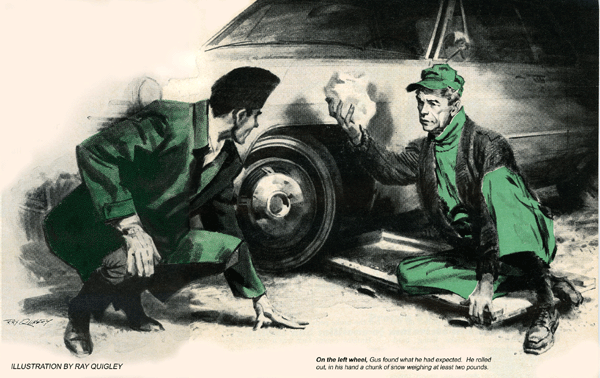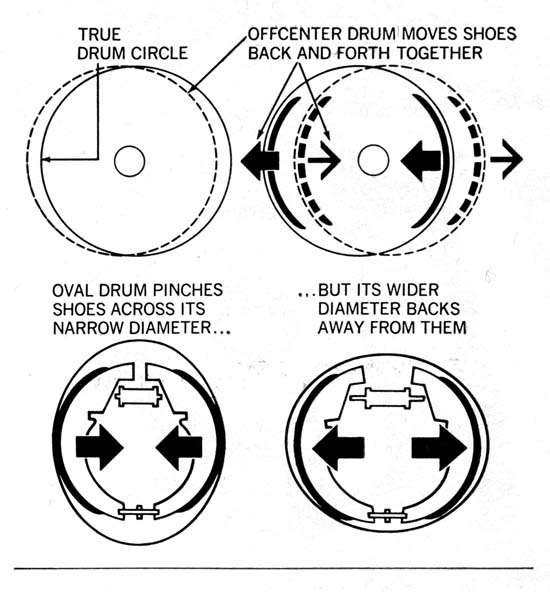December 1966
GUS KEEPS A
TWO-CAR FAMILY ROLLING
by Martin Bunn
Haskins was not a man
who could stand for any nonsense-
from his wife or his cars.
But this time he was riding for a fall.

"Hope I've seen the last of him for a while," muttered Stan as he closed the big shop door of the Model Garage behind a car. "A prize fusspot. Came back three times for adjustment he didn't need."
"On a below-zero day like this," said Gus Wilson, "maybe he kept coming in just to keep warm."
"It sure is cold," agreed Stan, looking out of one of the door's glass panes at the snow-packed street. "Hey, we're getting the carriage trade!"
He raised the door again, admitting a sleek '66 Cadillac. It moved into the slot Gus indicated, and the driver, a stranger to Gus, got out. He stood well over six feet tall, his height accentuated by a high-riding fur hat. Icy blue eyes in a long, bony face stared at Gus.
"I'm Peter Haskins, of Computer Industries. You're Gus Wilson?"
Gus nodded.
"Been having my car serviced by young Polcheck, who has that garage near the plant," Haskins went on. "But he's come up against something he can't spot, and recommended you. It's wheel tramp, or imbalance, so bad it almost throws the car off the road. It's intermittent-only shows up when I leave the plant."
"Not when you drive in the mornings?"
"Never has. But at lunchtime yesterday I used the car and there it was. So I left it with Polcheck. When I went back he said he'd found nothing wrong but a bit of brake chatter. Now it's back -- jounced me all over the road as I was driving here."
"We'll check it," Gus assured him, soon as we deliver two cars promised for noon."
"All right, I'll leave the car. It happens I left the plant early to go somewhere with my wife. She's meeting me here," Haskins consulted a wristwatch, "in exactly thee minutes."
A guffaw from Stan made Haskins look at him sharply. Gus's helper managed to transform it into a cough.
"You might fix that brake chatter if you can," added Haskins. "But the main thing is to get rid of that wheel tramp."
"Phone us later," suggested Gus. "Maybe we can have the car for you tonight."
Exactly three minutes later, a woman entered the shop. Almost as tall as Haskins, she marched straight toward the men, heels clicking on the concrete floor, and blue eyes furious.
"I ran out of gas," she said in flint-edged voice, "because the fuel gauge does not -- and I repeat not -- work."
"You're mistaken, Gerda," said her husband. "When I used the Volvo to get cigarettes last night I took special note of the gauge. It works, but you needed gas."
"It doesn't work, and the car's stalled a block from here. You take care of it."
"Stan, get a can of gas," said Gus.
Stan brought it to Haskins, who took it and walked out with his angry wife.
"Migosh," said Stan in awed tones when they were gone. "She really did get here in three minutes. And walking yet!"
Shortly afterwards a horn sounded at the gas pumps. It was Haskins, at the wheel of a Volvo fastback. Gus started gas running into the tank. The tall man watched the dash instruments in silence.
Gus removed the hose from the filled tank and wiped the windshield. At Haskin's request, he opened the rear door and took out the jerry can, catching a glimpse of the fuel gauge. It read "full."
It was afternoon before Gus turned his attention to the Cadillac, surrounded by puddles where snow had melted off it. He drove out, alert for the vibration Haskins has described. There wasn't a trace of it.
On a clear road, Gus increased speed.
The ride was dream-smooth even at 65. He applied the brakes to pull over for a turn.
Immediately the car shuddered, the brake pedal pulsating under his foot. Vibration shook the car at 60, at 55, at 50. Below that the chatter ceased.
Instead of stopping, Gus speeded up. With a clear road behind, he again put the brakes on at 60. Shudders shook the big car until speed once more dropped below 50, the pedal throbbing like a live thing. Gus turned and drove back to the shop.
There, he jacked up the front end. Both front wheels had balancing weights on them. He rolled his wheel balancer into position, fitted the gauge unit to one wheel, and let the machine spin it at high speed. Balance was good. He shifted the machine to the other wheel and got the same result.
Marking both wheels so they could be replaced exactly as before, Gus removed and set them aside. Then he pulled off the right brake drum. Its surface was clean and unmarred, the brake lining hardly worn. He removed the left drum. Its lining was discolored at the middle of each shoe. At two diametrically opposite places, the drum surface showed a bluish tinge. Gus got up, checked the part number, and sent Stan for a new drum.
While waiting for it, he put the right wheel back as marked, tightening the lug nuts in a crisscross order and evenly. After installing the new drum, he took care to pull all its wheel nuts up to the same torque reading. Then he drove out again.
On applying the brakes at 60, he sensed the same chatter and pedal pulsation, though much less severe. Gus pulled off the road, jacked up the left wheel, removed it and turned it the space of two lugs on the drum before retorquing the nuts.
There was no chatter or pulsation when he tried the brakes again at 60, nor did any repeated tests produce any.
"That intermittent wheel tramp never showed up," Gus reported when Haskins appeared at closing time. "But wheel chatter above 50 suggested a front brake drum was out of round. We found hot-spotting on the left one, so I installed a new drum."
"Don't see how a drum can wear off center in the mileage I have," said Haskins.
"Not off center. That wouldn't cause brake roughness unless the run-out was bad -- say a hundredth of an inch. With less eccentricity than that, the brake shoes float back and forth to follow the wobble. As one piston moves in while the other goes out, the amount of hydraulic fluid in the cylinder stays the same, and no back talk is transmitted to the pedal."
"But an out-of-round drum is oval," Gus continued. "When its' bigger diameter is across the shoes, hydraulic pressure shoves them out that much farther. When the narrow diameter is across the shoes, it pinches them in, squeezes the pistons together and forces fluid back, pushing out the brake pedal. All this happens twice every revolution."
Haskins craggy face was a study in concentration. "Then the brakes grip and ease off twice a turn, too, don't they?"
"Yes. You have uneven brake effort that causes the chatter. The narrow sides heat up more, and after a while that uneven heat makes the drum take on a permanent set. The only cure is a new one."
"I still don't see why a drum should go oval on a low-mileage car like this."
"It probably came that way from the factory," said Gus. "A drum that's oval by as little as 1-1/2 thousandths of an inch can cause chatter -- in other cars as well as Caddies, though you mightn't feel it as soon. Cadillac front drums are trued within half a thousandth, but a new drum can be distorted just by mounting the wheel, because the contact faces aren't exactly flat and even."
"Don't they test-drive the cars?"
Gus shrugged. "No assembly line has the time for that. It's up to the dealer -- or the buyer, if he notices chatter. Sometimes the cure is simply shifting a wheel around on the lugs to find a seating that doesn't warp the drum. I had to do that with the new drum I put on."
"I'll remember that next time I buy a car," promised Haskins. "And I'll be back here if that wheel tramp turns up again."
More snow fell that night, but about noon the next day, Gerda Haskins drove in. She stopped the Volvo, letting the engine run.
"Did you get a look at the gas gauge yesterday?" she asked.
Gus nodded. "It read full."
The woman smiled. "Look at it now."
Gus did so. To his surprise, the gauge wasn't registering. He switched on the radio. Mrs. Haskins smiled a Mona Lisa smile. The radio stayed dead.
"I hardly ever listen," she said. But I do like to know when I need gas. How can the gauge work for my husband and not me?"
Gus stopped the engine and switched to the "accessory" position. The fuel gauge needle swung over. Seconds later the radio came to life. Gus turned the key clockwise and started the engine; the radio and fuel gauge cut out as the starter churned. But they didn't come on again when he released the key to running position, and he had felt a little drag in turning it.
"Is this one of the original keys?" he asked, removing it from the lock.
"I lost the original recently. That's a duplicate made from my husband's key. It works all right," replied Mrs. Haskins.
Gus saw a slight burr on two of the keys notches. He got out and used a fine file to remove the roughness. After cleaning off filings, he handed over the key.
"The switch opens the accessory circuits while the engine is cranked," he explained. "It's supposed to close them again afterwards. But your new key hung up before it did, leaving the circuits open. Try now."
She got in and started the engine once more. Everything functioned.
"Wonderful. I'd like a bill."
"There's no charge, Mrs. Haskins."
She smiled. "Thank you. But please give me a bill. I've got to show my husband he was wrong, just this once."
It had been dark for some time when a horn sounded at the shop door.
"I said I'd be back again if that wild vibration started up again," Haskins barked. "Well, it did, the moment I left the plant."
The car was clean of snow except on the front bumper and wheels. Gus shut off the engine. Then he lay down on a crawler and rolled under the car. There was nothing on the right side, but on the left wheel he found what he expected.
He rolled out. In his hand a chunk of frozen snow weighing at least two pounds.
"There's your wheel tramp," he told Haskins. You probably park at the plant with the front end in a snow pile shoved up by a plow. When you cramp the wheels over to back out, one picks up a chunk inside the rim, where you can't see it. If it sticks you've got a king-size imbalance."
Haskins slowly turned red. "Why didn't you or Polcheck find it before now?"
"Because both of us had your car standing in a heated shop for a while before we test-drove it. By then, the warmth had melted away what lawyers call the weight of evidence. I'll bet your own garage is heated, so any snow in the wheel when you came home was gone the next morning."
"It is," nodded Haskins. "I apologize."
"All in the day's work," returned Gus, waving him on his way.
"How about that?" asked Stan as he slammed down the big door. "Still think come-backs in zero weather come back just to warm themselves up?"
"No. Actually, Haskins needed to cool off," quipped Gus. He thought I'd goofed on his car -- and that made him hot under the collar."
END
